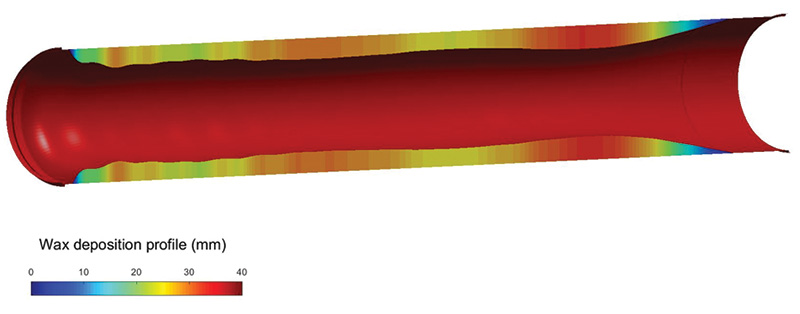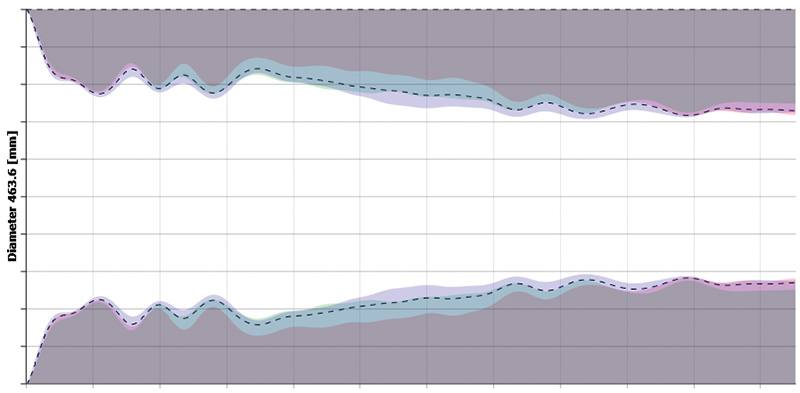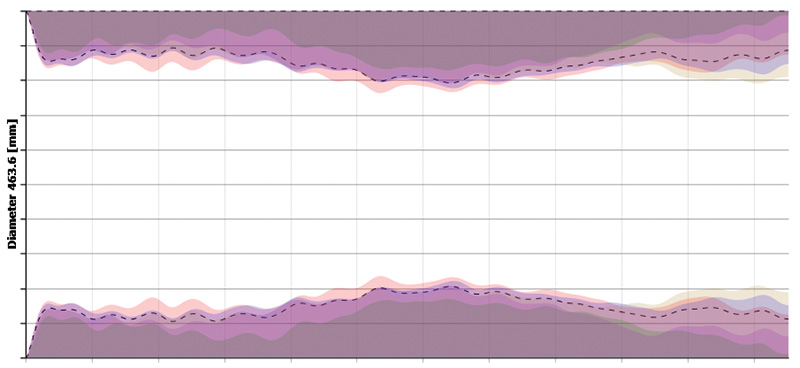October 2019, Vol. 246, No. 10
Integrity Management
New Diagnostics Technology Assesses Pipeline Pig Runs
By Neil Stewart, Pipeline and Process Services (PPS), Halliburton Pipeline
Pipelines can require both scheduled and unplanned cleaning for many reasons, from the maintenance of throughput to preparation for inspections runs. The most common method for removing debris from pipelines is using pigs and scraper tools.
However, this intrusive approach can be costly and high-risk, as well as lengthy because of the need for efficient cleaning of the pipeline while minimizing the risk of pipeline blockage and subsequent shutdown.
When planning a pipeline cleaning campaign, an operator often has limited knowledge of the actual conditions within the pipeline and therefore uses a conservative approach based on assumption and experience to devise a pigging program for the pipeline. This, therefore, limits the ability to plan cleaning operations optimally, cost effectively and safely.
By using newer, non-intrusive technology, pipeline operators can survey their assets to gain a clear understanding of the pipeline’s deposit profile in a safe and cost-effective manner without having to stop production or risk inserting tools into the pipeline.
For example, Halliburton’s InnerVue service works by collecting data in the field by connecting an ultra-high-speed data logger at either the inlet or outlet end of the pipeline via a small-bore connection. A pulse is then induced in the pipeline by operating a quickly closing valve at the same location the data logger is connected, therefore stopping flow and creating a fluid hammer or pressure wave within the pipeline.
This wave traverses the pipeline to the end point, then reflects and travels back to the pressure transducer point where the pressure variations are monitored and recorded to produce a signature of the pipeline response. After the survey, the datasets are quality checked, compared for repeatability, and checked for anomalous readings and then the data sets are analyzed individually using proprietary software to identify the pulse generation point and to compare against simulated pipeline models to create a pipeline deposit profile with a resolution of 3 mm of deposit thickness.
Because of the pipeline’s vital role for end-to-end supply, a pipeline cleaning operation is rarely undertaken without forewarning, considering that the significant amounts of planning and design of the cleaning campaign often run for months or even years.
All this is often performed with either only a theoretical understanding or little to no knowledge of the internal condition of the pipeline; therefore, it is common practice to use the worst-case scenario as the point for designing the program to limit potential risks involved. This means significant resources and costs could be expended when planning for a scenario that does not exist – whether it is because of purchasing too many pigs or chemicals, subcontracting more resources than necessary, or using more engineering and planning time than reality would dictate.
Using non-intrusive diagnostics such as InnerVue at the beginning of the planning phase of a cleaning campaign allows pipeline operators to collect information on the pipeline without production shutdown or risking an intrusive intervention. This knowledge is then fed into the planning strategy to help ensure that the planned remediation is targeted as accurately and efficiently as possible.
With the information gained, the pipeline operator can identify if the pipeline can be pigged, a starting point for the aggressiveness of the first pig run, the size of any chemical treatments necessary, and where they should be placed. Additionally, knowledge of the total volume of deposit in the pipeline provides guidance on how the debris removed from the pipeline should be managed and stored once it is received.
Once a pipeline cleaning campaign has been planned and mobilized operationally, it is best practice to monitor the progression of the campaign after each step to allow the campaign to be adapted and reassessed if it is not progressing as required or planned. Monitoring is normally performed by measuring debris volume received at the end of each pig run, evaluating its type and evolution, and assessing the condition of the received pigs. This method of monitoring has flaws that can significantly impact its effectiveness.
First, consider that debris received at the pig receiver could be washed farther into the process system and could flushed away both during the receipt of the pig and during the preparation of the pig receiver for opening. This means there will always be doubt concerning debris volume received, which causes a conservative estimate of the progress of the cleaning campaign to minimize the potential risk. Second, a “pigging subject matter expert” who has a subjective viewpoint should assess the debris received and this viewpoint could differ between individual experts.
Using InnerVue between pig runs, the actual remaining debris volume in the pipeline, debris volume removed from the system, and the new distribution of the deposit in the pipeline following the pig run can be calculated. Because results are completely objective, a conclusive decision can be made on the efficiency of the pig and progression of the cleaning campaign.
This means pigging campaigns, such as those run in preparation of an inline inspection can be tailored during operations to maximize its efficiency and reduce time and cost. During the early stages, the technology could confirm that the pipeline bore is suitable for metal bodied pigs before all foam pigs have been run.
Additionally, it might be possible to reduce the total number of cleaning pigs to be run if the technology confirms the cleanliness of the pipeline; therefore, saving time and resources by removing multiple pigs from the program based on results returned. In contrast, it might be the case that the pigging program as planned is not suitable to clean the pipeline, and results suggest that more pigs are necessary to complete the cleaning to the required level.
An offshore rig owned and operated by a major operator near Sakhalin Island faced a complex clean-out of their multi-phase export pipeline due to a “stuck pig” incident – just 40 days after the platform began production. This incident was caused by a build-up of hydrates and wax during the very first operational pig run. The extreme weather conditions in the North Pacific hindered pipeline access and limited the window of time for clean-out operations. But the deposition problem required immediate remediation, as it was slowing the transportation of crude oil, gas and condensate to an onshore terminal for processing in eastern Russia. There was also a growing threat of further wax deposit build-up from an extended period of low pressure and reduced flow rate.
In order to effectively plan the maintenance program non-intrusive diagnostic survey was performed in advance of the planning phase. The information gained from the survey, allowed the pipeline to be quickly and efficiently assessed as to the best way forward for the cleaning and assess whether the pipeline was in a piggable condition, required chemical treatment or a more direct intervention was required.
The initial survey indicated that the pipeline contained 1,718m3 of debris with the pipeline bore being reduced to 178 mm, approximately 8.6 miles (14 km) into the pipeline. This information allowed the starting point for the aggressiveness of the first pig run to be specifically tailored as well as the size of the chemical treatment, where that treatment should be placed and how the debris removed from the pipeline should be managed and stored once it was received.
As such a maintenance campaign, using multi-phase production fluid along with 18 different types of pigs specifically designed for wax removal was planned along with bespoke chemical treatment.
Once the project moved to the operational phase, it was necessary to monitor the progression of the cleaning to allow future works to be adapted and reassessed to ensure cleaning the progressed efficiently. Performing non-intrusive diagnostics between the pigging operations, the actual remaining debris volume in the pipeline, debris volume removed from the system, and the new distribution of the deposit in the pipeline following the pig run or chemical cleaning could be assessed.
At the midpoint of the maintenance campaign with seven pigs having been run the pipeline contained 1239 m3 of debris with the pipeline bore being reduced to 250 mm approximately 8.6 miles (14km) into the pipeline, Figure 8, bi-directional pigs with bypass to remove wax were being run.
Finally, after 14 pig runs in the pipeline a non-intrusive diagnostic survey confirmed that the pipeline had been cleaned to a level where on 20m3 of wax was left in the pipeline with minimal bore reduction and future maintenance of deposit build up could be managed with operational maintenance pigging (Figure 9).
Given the time and cost associated with planning and executing pipeline cleaning, detailed knowledge of the deposition profile and volume is important for planning a successful operation. The knowledge gained through non-intrusive diagnostics allows targeted cleaning or maintenance to be executed effectively, economically, and with minimal potential risk allowing pipeline operators to survey pipeline debris quickly and safely.
This insight into the internal pipeline profile provides fundamental data points to consider (i.e., Is the pipeline in a piggable condition? Is chemical treatment necessary? or Is a more direct intervention recommended?). Whichever method is necessary, knowledge gained by performing a nonintrusive survey upfront allows targeted cleaning or maintenance executed effectively, economically, and with minimal potential risk. P&GJ
Author: Neil Stewart is with Pipeline and Process Services (PPS), a Halliburton service product service line. He joined PPS in 2017, with a focus on pipeline diagnostics and flow remediation solutions. Stewart studied chemistry at Robert Gordon University and holds a post-graduate certificate in project management from the same institute. 









Comments